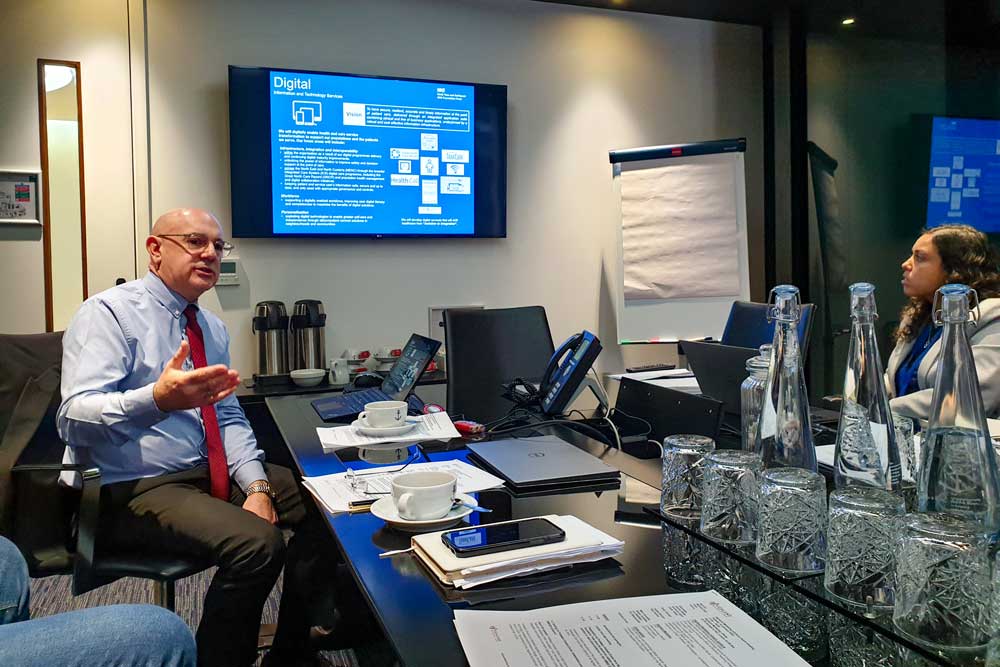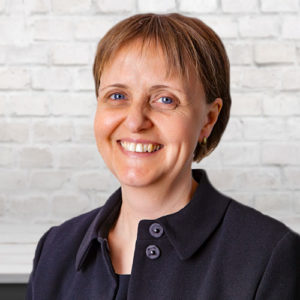At its January 2020 meeting, Highland Marketing’s advisory board heard from Professor Graham Evans, chief information and technology officer for North Tees and Hartlepool NHS Foundation Trust, and chief digital officer for North East and North Cumbria Integrated Care System.
This briefing provides further information about the organisations and their digital progress; which includes exciting work to close the loop on e-prescribing and medicines administration. It also provides background information to the board’s debate about how to measure and encourage digital maturity across health economies.
About the speaker
Professor Graham Evans is chief information and technology officer for North Tees and Hartlepool NHS Foundation Trust. He is also chief digital officer for the integrated care system for the North East and North Cumbria.
Professor Evans is a chartered engineer by background and holds a professional doctoral degree in technology enabled transformational change. He worked in the private sector before joining the NHS in 2004, has worked at trust, regional and national levels in the health service. He took up his present roles at the trust in 2016 and at the ICS in September 2018.
About the trust
North Tees and Hartlepool NHS Foundation Trust is an integrated hospital and community services trust that provides health care services to a population of 400,000 people in the North East. Its catchment area runs from Easington in the north and Hartlepool in the east, to Stockton on Tees in the south and Sedgefield in the West.
Like many others, the trust was formed in a series of mergers, initially between two acute providers (1999) and then with a community trust (2008). As a result, it runs two main hospitals – the University Hospital of Hartlepool and the University Hospital of North Tees, in Stockton on Tees.
The trust has a turnover of over £300 million, 4,600 staff, and is rated ‘good’ by the CQC, with a programme to become ‘outstanding’.
About the ICS
The North East and North Cumbria ICS is a third-wave ICS and the largest in England, covering four integrated care partnerships. North Tees and Hartlepool NHS Foundation Trust sits in the ‘south’ ICP, which covers the Tees valley.
The ICS model emerged from the proposals for population level planning and integrated care delivery first described by the NHS Five Year Forward View, and then taken forward by sustainability and transformation partnerships and the NHS Long Term Plan.
North East and North Cumbria ICS says that while “the overall quality our health and care services is good, the general health of our populations remains poor”; so its priorities are to “fundamentally shift health outcomes” and to tackle inequalities.
Trust digital strategy
In a recent interview for Highland Marketing, Professor Evans pointed out that North Tees and Hartlepool has a history of tech innovation. It used the National Programme for IT to implement its first PACS and A&E systems, was an early adopter of electronic document management, and was one of the first trusts to roll-out wi-fi.
Then, in October 2015, it deployed the TrakCare electronic patient record from InterSystems. It has also been working on a Scan4Safety project to use barcoding to improve the way patients, products and places are identified and tracked.
Against this background, it published a digital roadmap in 2018 to support its business priorities and the digital-first reform agenda being taken forward by the Health Call collaboration of six North East foundation trusts.
The strategy says the trust is aiming to “continually improve digital maturity”, to “deliver paper-light information and technology services by 2020”, to improve the digital literacy of staff and digital access and control for patients and carers, to align with local digital roadmaps and to “integrate with the Great North Care Record and broader system digital initiatives.”
GDE status
The trust is also part of the global digital exemplar programme. It is the fast follower for Royal Liverpool and Broadgreen University Hospitals NHS Trust, which is one of three Liverpool acute trusts due to deploy the InterSystems TrakCare electronic patient record.
However, some of these trusts are yet to go-live, which puts North Tees and Hartlepool in the unusual position of being a digitally advanced GDE fast follower. As part of the GDE programme, the trust was committed to reaching level 5 on the HIMSS EMRAM maturity model.
EPR deployment
North Tees and Hartlepool NHS Foundation Trust was the first trust in the country to go live with TrakCare when it completed its first phase deployment in 2015. In this first phase, it replaced its legacy patient administration system, replaced a number of modular clinical systems and rolled out electronic forms, such as discharge summaries.
Professor Evans often says that when he arrived at the trust nine months later, it had “given birth” to the new system but “there were a lot of teething problems.” He has also been known to compare working on a first of type deployment to “working in the wild west”; sometimes, he told InterSystems’ Joined up Health & Care conference two years ago, his team just had to “pull a bunch of arrows” out of their hats and “get back on the horse”.
Pause and move on
The trust paused the deployment to focus on infrastructure, security and user experience. Professor Evans says that one of the first lessons he learned is that it is essential to “get the basics right” because no EPR will be used on flaky infrastructure and slow devices.
“When I read stories saying that some clinicians have 15 logins and that the NHS is going to spend £40 million on sorting out slow login times, it resonates with me, but it also frustrates me,” he told the advisory board. “Because I have said for years that if you want to transform care with IT, you cannot have people struggling with IT. IT needs to be a utility. It just has to work.”
The trust also strengthened leadership and clinical engagement. “You need the board on board,” he said. “However, you need to get staff engaged. It is mission critical to get clinicians to lead on this.” Then, it started a modular roll-out of TrakCare to new areas, such as theatres and A&E, the latter is now all-but paper-free.
It also deployed clinical functionality including e-prescribing and medicines administration, which went live across the organisation in nine months, and nursing observations and alerts, learning from Royal Liverpool and Broadgreen’s work on sepsis.
The trust is now revising its IT roadmap with a view to achieving paper-lite rather than paperless working. Professor Evans argued that paper-lite is “safer” than paperless, since some paper processes will always be needed for business continuity or, as he put it: “to make sure that people can get things done if the servers go down and it all goes pear-shaped.”
HIMSS assessment
While Professor Evans stresses that North Tees and Hartlepool has not gone digital for the sake of it, but to support transformation and to benefit staff and patients, he also argues that HIMSS EMRAM is useful as an international benchmark that is independently assessed.
The trust recently went through its final HIMSS EMRAM assessment and achieved level 5. To do this, an organisation must have all of what HIMSS calls the ‘ancillary clinical systems’ in place (pharmacy, laboratory and radiology), be using digital imaging, e-prescribing, nursing and clinical documents, be feeding information to a central data store, and to have role-based security and basic business continuity in place.
To reach level 6, it will additionally need to have closed loop systems in place for medicines and blood products. To reach level 7, it will additionally need more advanced security and privacy systems, to be using data for analytics, and to be feeding to an external health information exchange.
Closing the loop
In his presentation to the advisory board, Professor Evans said he was confident that the trust could reach level 6. “All of our issues are around medications and closing the loop on e-prescribing and medicines administration,” he said. “We think that the system we have developed through Scan4Safety, CareScanPlus, will help us, because that will get us down to blister-pack level.”
In other words, the trust will be able to use barcode scanning to track a medicine from a doctor prescribing it, to its pharmacy dispensing a pack of it, to the pack arriving back on a ward or other area for administration. But that still leaves the final step of confirming that the correct dose has been given to the patient.
“We think we have found a product, to help,” Professor Evans added. “You put the tablets into a beaker, and it scans them, and uses AI to match them to a database. We are looking to integrate that with TrakCare and, if that works, we think we will have cracked it.”
Andy Kinnear, director of digital transformation at South, Central and West Commissioning Support Unit,said that if it did, the trust should publicise its work because the issue was holding up other, digitally advanced organisations. “It will be a big break-through.”
HIMSS 6 and 7
However, Professor Evans suggested that even if the trust could get its HIMSS 6 accreditation, it might not go for it immediately. Its GDE funding does not depend on it.
Level 7, meanwhile, looks relatively straightforward. InterSystems is planning a TrakCare upgrade that should deliver the necessary analytics, while North Tees and Hartlepool is already involved with the Great North Care Record, which has chosen Cerner to run a Health Information Exchange out of Newcastle Hospitals NHS Foundation Trust on behalf of the North East and North Cumbria ICS region.
Regional plans
In its digital roadmap, North Tees and Hartlepool says it has a “clear and unequivocal” commitment to its ICS, to collaboration and joint working, and to using digital technology to “create the opportunity to ‘not do the same thing better’ but ‘to do better things’.”
Professor Evans says this means making sure that all organisations have the digital maturity to contribute to the Great North Care Record, which will be supported by a patient engagement platform that could be linked to the NHS App as “a digital front door” to local services.
Meanwhile, the Health Call consortium supports innovation at its member trusts and enables them to share contracts and best practice for ‘hospital at home’ services provided by a commercial partner. “My vision for the future is one where we get the basics right, and then use population health and AI to deliver real change,” he told the advisory board. “The sky is the limit. We have to get on and start delivering.”



